Many overlanders who drive through South America end up visiting the Galapagos Islands. The downside: it’s an expensive trip. The upside: you’re right there! When will you have a better opportunity to go?
As our family of three drove through Colombia for five months, getting closer and closer to the Galapagos, we kept the famous islands in our sights. But with our first flight back to the U.S. in 18 months and uncertainty around the renewal of our temporary import permit in Ecuador, it was impossible to plan in advance.
Instead of detailed planning, we ended up taking a spontaneous 10-day trip to the Galapagos Islands. On July 7, I asked my husband Eric if he wanted to go. On July 15, we were flying out of Quito. All my planning happened in eight days!
I’m here to tell you a spontaneous visit to the Galapagos is not only possible, but it can be extremely rewarding! If you’ve waited until the last minute to plan, then these tips will help your visit go more smoothly.
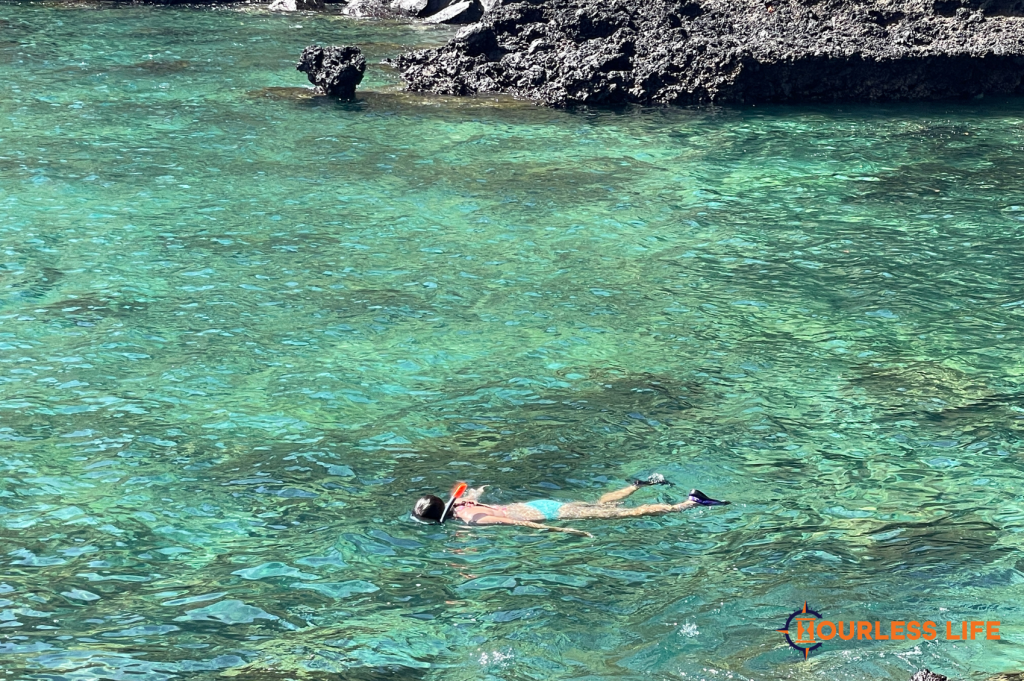
Self-tour or tour package?
Many people opt for a tour package when they go to the Galapagos. It makes sense. The planning seems daunting and a tour package ensures the logistics are covered. However, multi-day tours are expensive. The average five-day tour is about $3,000 per person, not including flight to the islands.
If that amount is out of your price range (it’s definitely out of ours), then you’ll want to self-tour. Self-touring means you do the planning yourself. You choose which island to start on, where to stay, what activities to do, and where to eat.
Self-touring the Galapagos Islands allows you to control the budget. You can funnel your funds into adventurous day trips, relaxing hotels, or pricier restaurants. The choice is yours.
On the negative side, the weight of planning is on you. But as you’ll see throughout this article, visiting the Galapagos Islands only needs to be as complicated as you make it. Before we went, all we had planned were our flights and hotels…and I ended up cancelling and rebooking three of our hotel stays after we arrived!
Let’s get into specific things you should know before self-touring the Galapagos Islands.
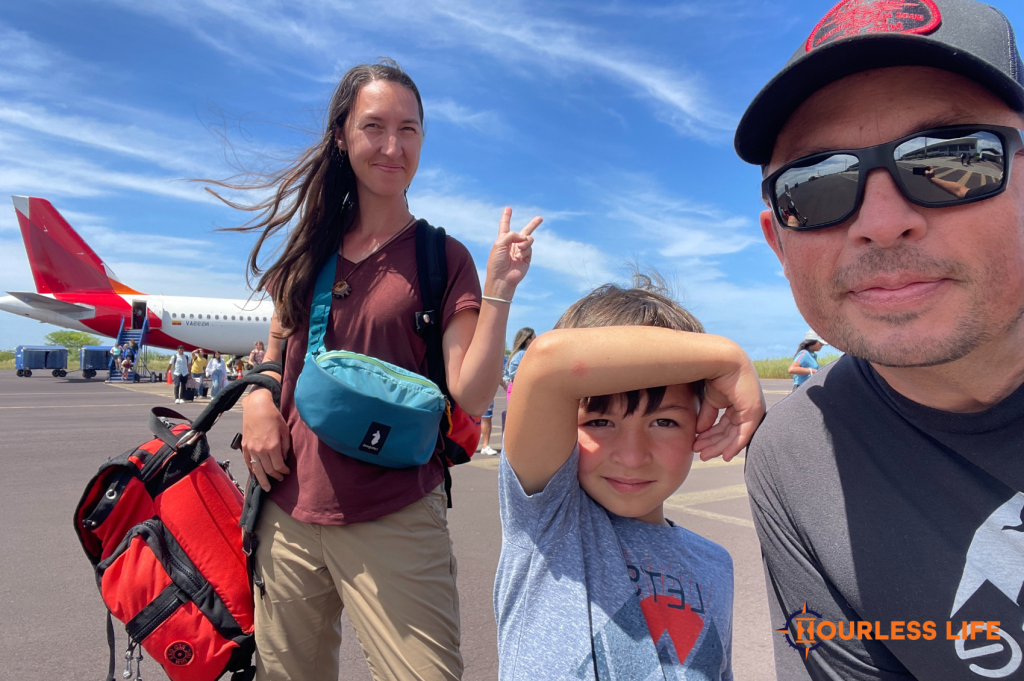
1/ Which airport to fly into
You will fly into one of two airports: Santa Cruz or San Cristobal.
Santa Cruz is the more popular choice. There are two things you should know about flying into the Santa Cruz airport:
- You are in the ideal location for ferrying to the other big islands. Santa Cruz is between Isabella to the west and San Cristobal to the east. If you choose to go to either of those islands, you’ll only need to take a two-hour ferry either way.
- However, the Santa Cruz airport (Seymour/GPS) is not close to the town of Puerto Ayora, the coastal town where most people stay. So once you land and get through immigration, there are several transportation steps you still need to go through. First, a $5 bus ride, which lasts 10-15 minutes. Then a $1 water taxi. Then either another bus or a taxi (about 45 minutes long). After what may have already been a long travel day, this is a lot to navigate.
You have a second airport option on the island of San Cristobal (SCY). This is the airport we chose, based on advice from friends.
- Unlike Santa Cruz, this airport is right on the edge of town, called Puerto Baquerizo. We were able to hop off the plane, go through immigration, and walk straight to our hotel with our backpacks. It was a steamy walk, but it took less than 10 minutes. Especially traveling with a six-year-old, flying in and out of San Cristobal simplified our travel days.
- The downside is San Cristobal is the far east island. This means if you want to go to Isabella, you have to take two two-hour ferry rides to get there. This may not be ideal for people who struggle with seasickness or are traveling with small children.
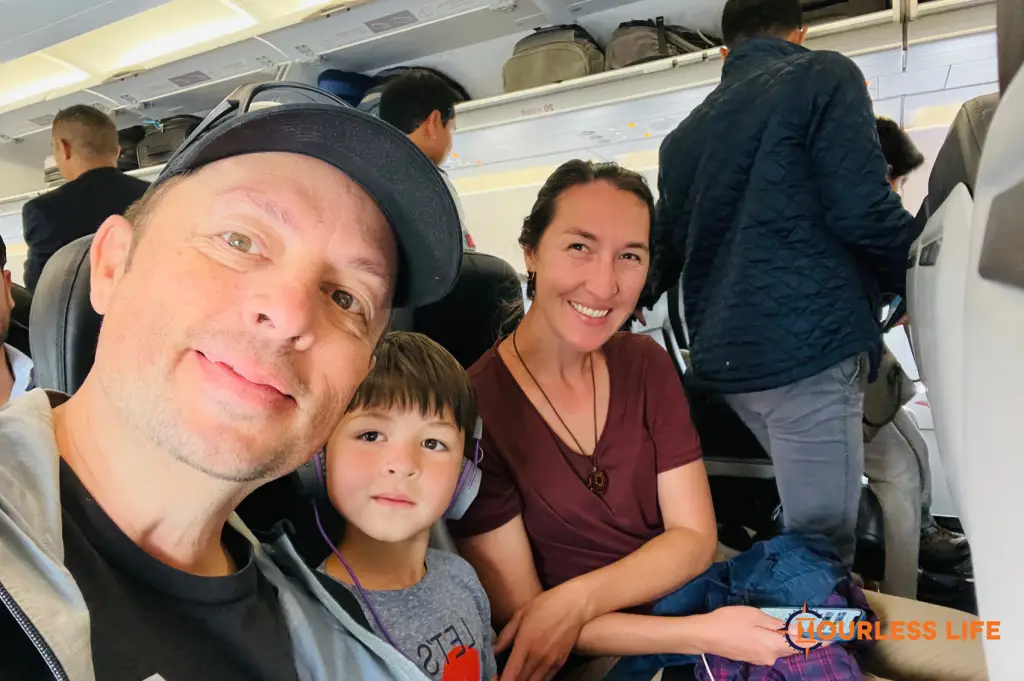
2/ Flight rules are baffling
There are three airlines that fly into the Galapagos: Avianca, EQUAIR, and LAN Airlines. Since we had a positive experience flying Avianca from Costa Rica to Canada in 2022, I went straight to them for our Galapagos tickets.
We only needed small backpacks for our 10-day visit, so I bought the least expensive flight package from Avianca, called XS. After tax, three roundtrip tickets from Quito cost a total of $583. Given how last-minute I purchased our tickets, I thought this was reasonable.
Then I got the bad news. An overlanding friend told me lower-cost flight packages are for Ecuadorians only. Non-Ecuadorians are required to purchase the L flight package. If they don’t, they will be charged a $150/person fee at the airport. What?!
As you can imagine, the cost difference between the XS and L packages is fairly substantial, especially for a family. My mind was reeling. I went back on the Avianca website and acted like I was buying tickets again. I read all the small print and looked for pop-up messages. I didn’t see anything about this anywhere.
I started searching blog articles. It took me a couple of days, but eventually I did find references to the flight restrictions in two obscure blog articles. We tried to contact Avianca, but none of the customer service options worked for us. We couldn’t get through to a real person. We decided to hope for the best, but we were prepared to pay the fees at the airport if necessary.
After feeling anxiety about this for days, we breezed through the airport with no problem and no penalty fees. It may have helped that we checked in online and got digital boarding passes–I don’t know. Eric was paged to the gate in Quito right before boarding. We thought for sure they wanted us to pay the penalty. But even though they checked our U.S. passports and transit cards, so they knew we were non-Ecuadorians, they didn’t say a thing.
So I don’t know what to recommend. A friend saw people paying the fee at the airport, so it’s definitely a real thing. But we did not have to pay and I read online that the policy is enforced haphazardly. Nonetheless, I don’t want it to be a surprise for you, like it was for me. (Random thought: if Avianca is going to enforce a $150 penalty, shouldn’t there be a big, noticeable message on their website during the purchase process?)

3/ Compulsory Galapagos fees
The Galapagos Islands have a reputation for being expensive to visit. A big part of this are the compulsory fees tourists must pay. At the Quito or Guayaquil airport, each person owes $20 for a transit card. You can pay with credit card, but be sure not to lose the card during your stay. It’s like a visa giving you permission to be on the Galapagos Islands.
You’ll pay the far bigger fee at the airport where you land (either Santa Cruz or San Cristobal). Non-Ecuadorian adults pay $100 for a national park fee and children pay $50. This must be paid in cash.
The other abnormal fee we encountered was at the port in Santa Cruz. When arriving and departing the island by ferry, we had to pay $1/person.
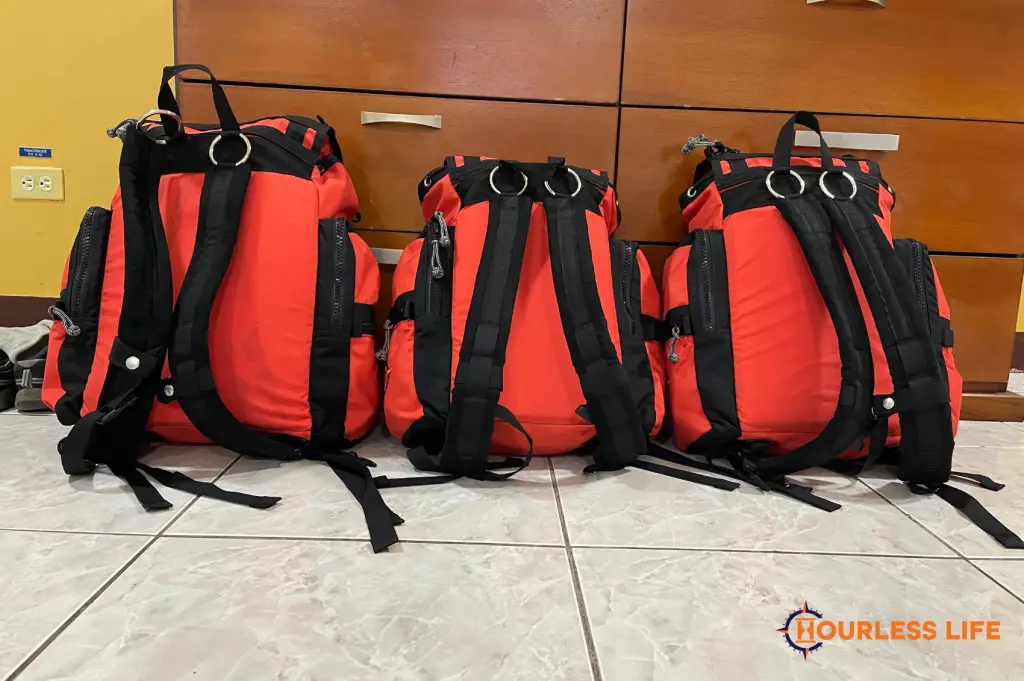
4/ What to expect at the airport
Okay, so let’s back up a tad to make sure you know what to expect at the airport. I’m writing based on our experience at the Quito airport, but the process should be the same if you’re leaving from Guayaquil.
When you walk into the terminal, you need to go to the large booth to get your transit cards. There are signs asking you to submit a form on your phone, but we didn’t. The official in the booth let us skip the form altogether.
Next, you need to go through luggage check. I envisioned a serious process to make sure we weren’t bringing invasive species into the Galapagos Islands. But instead we dropped our backpacks onto a conveyer belt, watched them go through, and barely received any acknowledgment from the officials. If you’re checking bags, they’ll get tagged. If not, then you won’t get a tag.
After we went through “luggage check,” we ended up going across the street to hang out at a lounge. No one cared that we left or skipped the luggage check on the way back inside. The Galapagos luggage check is super low-key.
The rest is normal airport stuff. Remember, we checked in online and had our digital boarding passes. So once it was boarding time, we made our way to the gate. An official checked our passports and boarding passes. Then we went through a more official security check-point, with the typical metal detectors.
Once you land at either Santa Cruz or San Cristobal, you need to go through extra steps in the terminal. One official will check your passports and transit cards. Right after that, you’ll pay the cash-only national park fee. As you keep walking, a final official will take the declarations card you filled out on the plane. In the San Cristobal airport at least, this felt like a formality. The official didn’t even look at our cards before we walked away.
That’s it! Now you’re ready to find your lodging and start enjoying the Galapagos Islands!
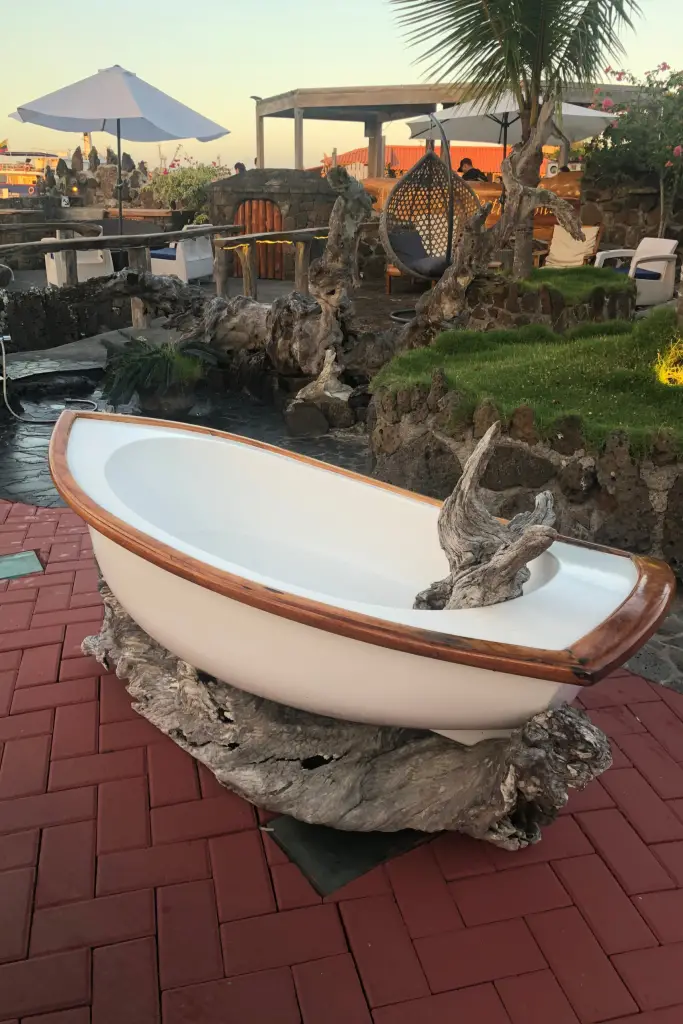
5/ How water taxis work
Water taxis are a foundational part of the transport infrastructure across the Galapagos Islands. Typically, your ferry between islands will not go all the way to the dock. It will arrive in port, then a water taxi will pull up to take passengers between the ferry and the dock. Water taxis are $1/person. We did not pay for Caspian.

6/ Where to see the animals
Now we get to the fun part. Since you’re self-touring, rather than relying on a tour operator, you probably want to know where to see the legendary Galapagos animals!
We didn’t know it at the time, but we were spoiled visiting San Cristobal first. I don’t want to make sweeping generalizations, but we had exponentially more animal encounters on San Cristobal than we did on Santa Cruz.
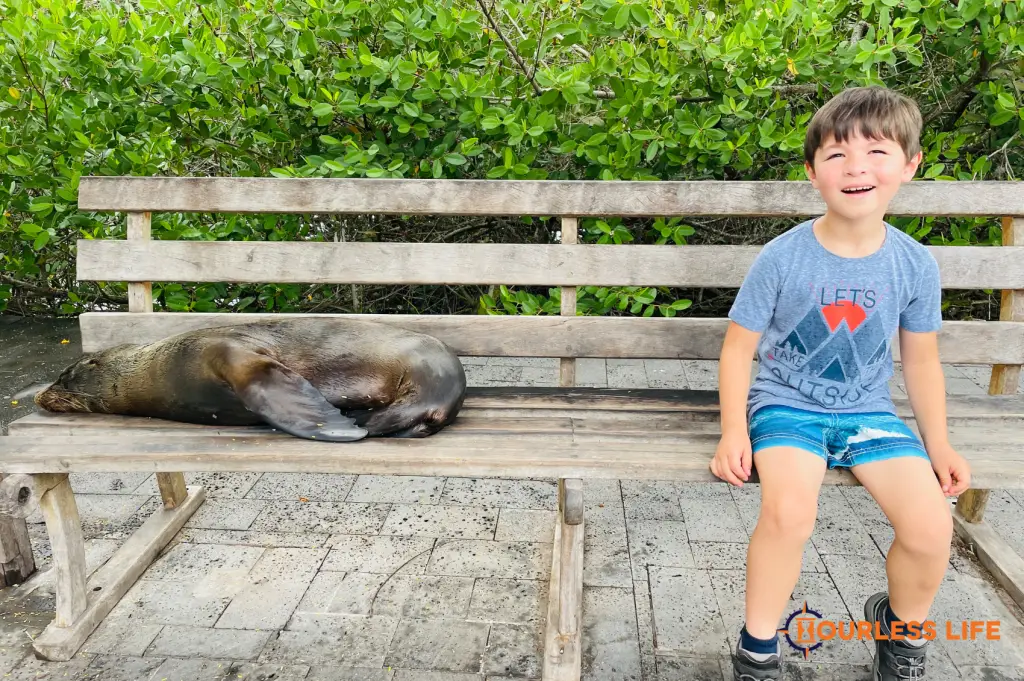
This is how it started for us: we dropped our bags off at our hotel, spent a few minutes recuperating in the air conditioning, then set out to find lunch. In a few minutes, we were at the malecon (pedestrian walkway on the water). Immediately, we started seeing sea lions playing in the water, crabs scuttling across the rocks, and marine iguanas bathing in the sun. It was magical.
There are sea lions everywhere on San Cristobal, I believe because there are more sandy beaches for them to have their babies and sleep at the end of the day.
The species that seemed more populous on Santa Cruz was the marine iguana. If you turn right from the dock and walk along the water, you’ll eventually reach the fish counter. That was where we always saw marine iguanas (including lots of babies), a few sea lions, and usually pelicans.

If you want to see species like the blue-footed booby, albatross, or hammerhead shark, then you’ll need to take charter trips to smaller, unpopulated islands. These day trips usually cost at least $200/person. We did not invest in this on our first trip to the Galapagos. But I can see us trying to track down rarer animals if we ever return. For example, I was hoping to see a manta ray, but that didn’t happen during our visit (we did see smaller rays and white tipped sharks while kayaking off Tortuga Bay on Santa Cruz).

7/ How to get between islands
There are small planes that fly between islands, but they are cost-prohibitive for us common folk! Ferries are the most common means of transportation between islands. Here are a few things to know about them.
Ferries run between San Cristobal, Santa Cruz, and Isabella. Each island-to-island crossing takes about two hours (depending on sea conditions) and costs $30/person. If you want to go from San Cristobal to Isabella, then you’ll have to take two separate ferries and the total will be $60/person for the two tickets.
There are usually two ferry departures each day, in the early morning and mid-afternoon.
Most importantly, you should know ferries fill up. By reserving your spot in advance, you guarantee you can keep your hotel and activity reservations on the next island. We got our first ferry tickets three days in advance, from San Cristobal to Santa Cruz, then on to Isabella the same day. The next time, we were trying to purchase tickets five days in advance from Santa Cruz back to San Cristobal. They were already sold out, so we had to pick a different ferry and change our hotel reservation.
It is possible to buy ferry tickets online before you go to the Galapagos Islands. $30/person is the typical cash rate, but you will pay an additional 10-12% if you’re paying with credit card.
If I had to do it over, I think I’d do it the same spontaneous way. We changed travel plans several times after arriving in the Galapagos. Not having ferry tickets gave us flexibility to make those changes. But you may prefer to have set plans.
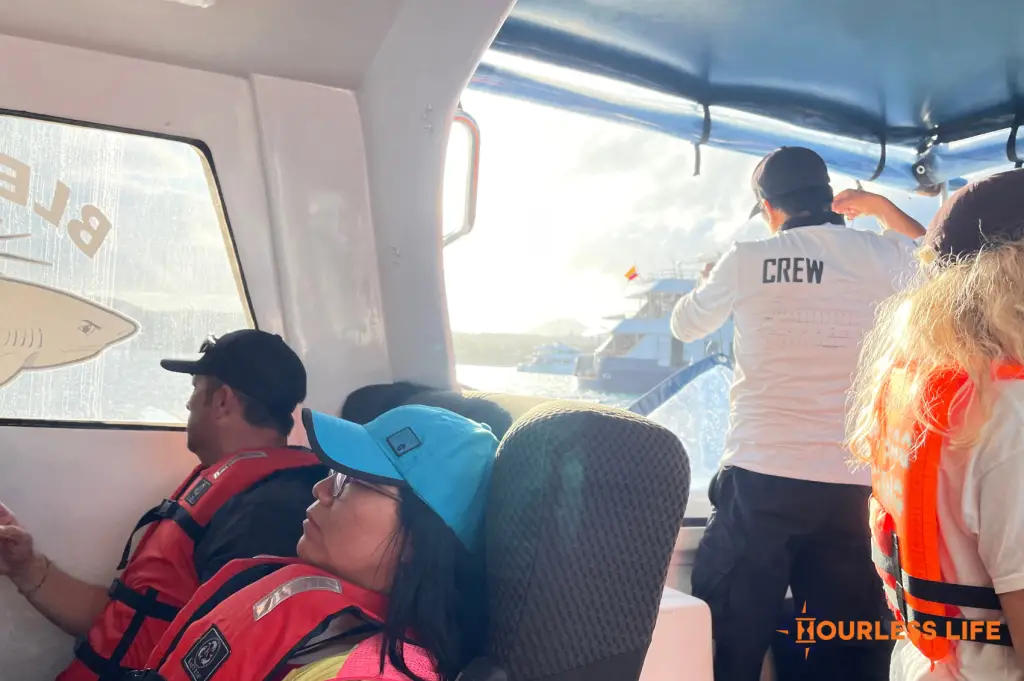
8/ Ferry survival tips
You should also know what the ferries are like. They are much smaller vessels than I expected, fitting about 30 passengers. Because of their size, it’s a bumpy ride. Caspian got seasick on our first trip from San Cristobal to Santa Cruz. He was affected so much that we scratched our visit to Isabella altogether, just to avoid the ferry rides there and back.
Ferry survival tips:
- Do not consume dairy products the morning of your ferry ride.
- Stay hydrated.
- Plan to keep your eyes closed during the crossing. Listen to a podcast episode or music to pass the time (make sure everything is downloaded because you won’t have phone signal).
- When you have your eyes open, look at the horizon line or a fixed point (like a tree on an island).
- If the temperature is high, dress in light clothes for the crossing. The rear bench seat is in open air, but the cabin of the ferry can be stifling hot and passengers are required to wear life jackets.

9/ Bring your own swim shoes and snorkeling masks
All three of us packed swim shoes and snorkeling masks. There are lava rocks at most snorkeling locations, so swim shoes protect your feet. There are snorkeling masks for rental on the islands, but they will run you $5/use and are well-used (so you’ll have reduced visibility through the older plastic). By bringing your own mask, you save money in the long-run and have flexibility to go snorkeling whenever you want without having to track down equipment.
We purchased snorkeling masks and swim shoes for me at Kao Sport in Quito. I believe there are multiple locations, but we went to the one in Portal Shopping mall. The masks were $15 each and there was a large selection of swim shoes for men, women, and children.
We didn’t take flippers because we didn’t have room in our backpacks. But we were so buoyant in the ocean water that we didn’t miss having them.

10/ Food doesn’t have to be expensive
I was so used to people saying how expensive the Galapagos Islands are that I assumed restaurants must be super expensive. But that isn’t necessarily true!
It is easy to find $5 meals by eating like a local. These plates are the typical bean, rice, and meat medley. In Puerto Baquerizo, Don Nelson serves up delicious empanadas for $1.50 each. That was our favorite low-cost meal on the islands.
But even the fancy places are not overly expensive by U.S. standards. This trip was a celebration of Eric’s birthday and Father’s Day, so on Father’s Day we had a special dinner at Isla Grill on Santa Cruz. Both Eric and I had steak and he added shrimp. I enjoyed an adult drink. All in for three people, our Sunday evening meal was $81.

11/ Hotel hacks
We booked all four of our original hotel stays through the Capital One travel portal. Our Venture X card (referral link) gives us 10X points when we book there.
Originally, we planned three nights on San Cristobal, two nights on Isabella, four nights on Santa Cruz, then one last night on San Cristobal before flying out. Our San Cristobal hotel had free cancellation and I paid a bit extra to allow for cancellation at the other hotels.
We ended up nixing our Isabella stay, extending on Santa Cruz at a different hotel, and adding an extra night on San Cristobal. Lots of changes! Here’s what we learned:
- If you have flexibility to make hotel reservations on the ground, the cash price will be better than paying with credit. On Santa Cruz, we didn’t like our room at the hotel we booked in advance. Instead, we found a lovely, family-owned place called Hotel Coloma. They offered us $84/night cash for a double room with breakfast included for all three of us. If we wanted to pay with credit card, it would be $94/night.
- Hotel Coloma was $141/night on the Capital One travel portal. So we saved a ton of money by booking in person, even at the credit card rate.
Bottom line: you will save money on hotels by booking in-person and paying cash. We visited from July 15-25 and there were several hotel options to choose from when trying to book same-night. Peak season is considered mid-June to late August and mid-December to mid-January, so we were visiting during peak season.
Obviously you will have a larger selection to choose from if you book in advance, potentially saving you from disappointments and rebooking.

12/ Last-minute isn’t impossible
Like I said at the top, you can do a spontaneous, loosely-planned self-tour of the Galapagos Islands and still have a wonderful time. If we can do it with a six-year-old, then you can do it, too!
This article has been a collection of the top tips I wanted to share about self-touring. But there are many other stories and suggestions on my mind! If you still have questions after reading this article, then please don’t hesitate to leave them in a comment.
My husband wanted to live on the Galapagos Islands after our 10-day visit. We had a peaceful, inspired time there. We hope your trip will be equally unforgettable.
-B

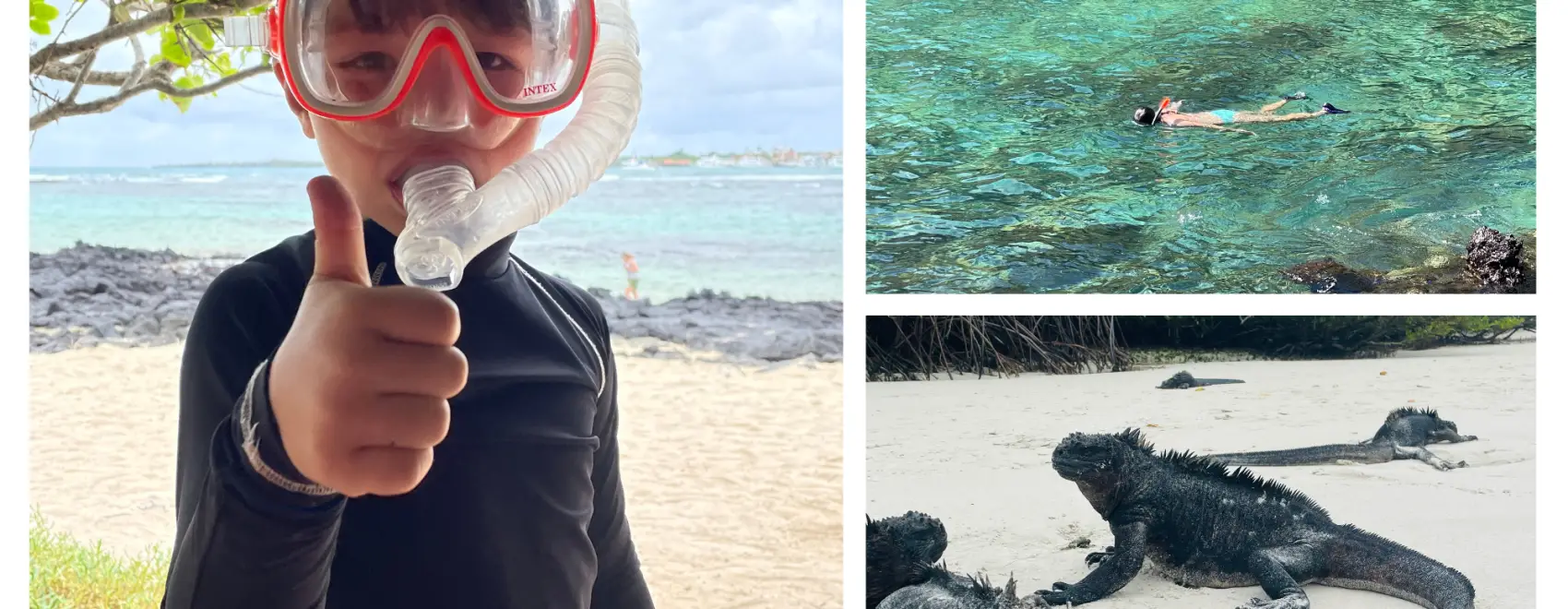


Leave a Reply